Choosing the Right Pot for your Succulents
Selecting a pot or planter for succulents is often overlooked but it's an important part of keeping your succulents happy and creating a beautiful arrangement!
Succulents and Sunshine is reader supported. We may earn a commission, if you purchase through links on our site, such as Mountain Crest Gardens, Amazon, or Etsy. We only promote products we use and trust.
When it comes to succulents, the only thing I enjoy more than buying succulents is choosing the pottery to plant them in. I'm especially addicted to blue pots. My goal is to one day have two giant teal blue pots on my front porch, both filled with bright orange succulents. Sounds great right?
But as much as I love buying pottery and planters for succulents, it can be a challenging task to find just the perfect one. Over the years, I've discovered a few things that are important to consider when choosing a pot, that many beginning succulent growers don't think of.
All of these factors can make a big difference in helping your succulents thrive.
To help you even further, download my free cheat sheet to see what it looks like when your succulents need more or less water. Click here to grab that, it'll be super helpful.
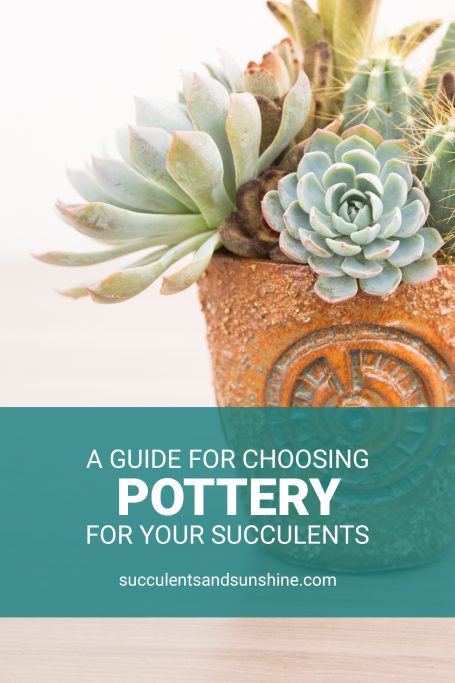
Drainage!
If you've read my posts on watering or soil, you've likely already heard me say… choose a pot with a drainage hole! If you come away from this post learning nothing else, remember to get a pot with a drainage hole.
Seriously... this will make your life so much easier, as it takes a lot of the guesswork out of watering succulents.
If you find a pot you absolutely love that doesn't have a drainage hole, you've still got options! You can add drainage to most containers with a diamond tip drill bit.

I love using Susan Aach's pottery (like this one above) because she always includes large drainage holes. In fact, her pots are designed specifically to use with succulents.
Snappy Pots are another great planter option designed to be used with succulents. They have drainage holes and fun decorations that you can add to change up how your succulents look throughout the year.
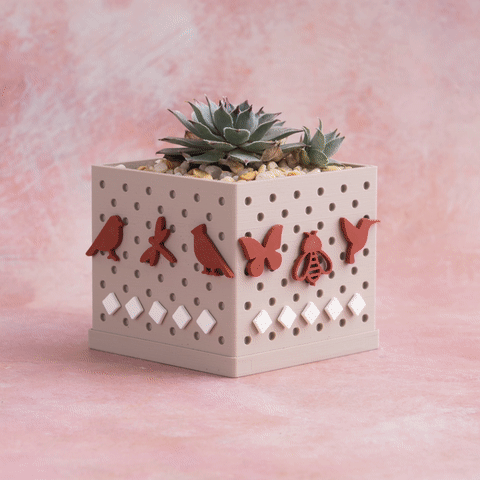
You can use mesh tape to cover the holes to keep the soil from falling out. Mesh screens are also another great option as they keep the soil in but allow the water to flow through easily.
As you become more comfortable with watering your succulents in a pot with a drainage hole, you can branch out and try some pots without drainage. But again — if you're just starting out with succulents, a drainage hole will make things much easier.
Material
The next consideration is the material your pot is made of. Some common pot materials include ceramic, plastic, wood, metal and glass. So which material is best? It depends on the location of your arrangement.
Terra Cotta or Ceramic
Terra cotta and ceramic are both fairly breathable materials, which means they'll work well in areas that might not get a lot of air flow. In fact, I've found they work well indoors as well as outdoors.
In direct sunlight, a terra cotta or ceramic pot can heat up–which isn't ideal for succulents, but usually isn't a huge problem. Keep in mind though, that your soil will dry out more quickly if it's left in direct sun.
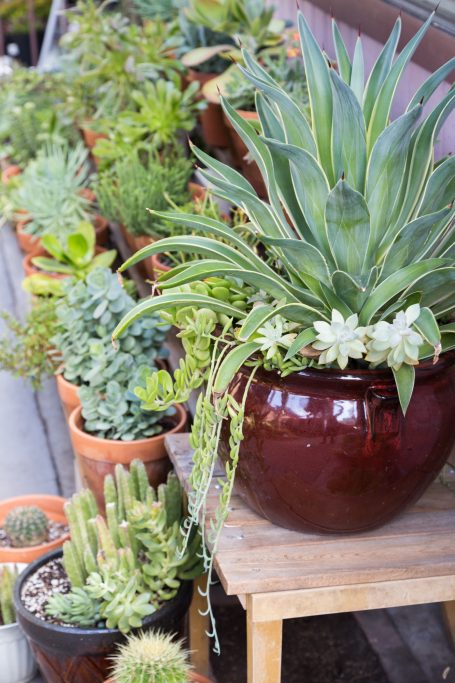
The hard thing about terra cotta and ceramic pots is they can be extremely heavy. If you choose to grow in a large pot, you may find that it's difficult to move after (and maybe even before) the soil and succulents are in.
These types of pots are also quite fragile so you have to be careful not to drop them or knock them over.
Plastic
Plastic is another popular option for pots and planters. A huge advantage to plastic is that it's not as fragile as ceramic and is often a lot lighter. The downside is that it isn't as breathable as terra cotta or ceramic. It's much harder for water to evaporate in plastic pots than pots made from other materials.
But if you use a well-draining soil and have a drainage hole in your pot, this lack of breathability shouldn't be an issue. Plastic planters come in a huge variety of colors and shapes which makes them really fun to shop for.
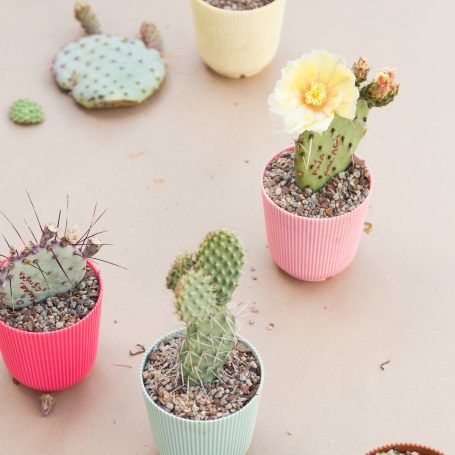
Wood
If you're looking for an unusual way to plant your succulents, wood is a really interesting option. I love the driftwood planter I made last summer. It's much more eye-catching than your typical pot or planter.
Plus, wood is helpful for succulents that sit in direct sun or hot environments because it stays cool and retains water.

On the other hand, if you're planting in an area with less sunlight and airflow you may find that wood can easily rot or keep your soil wet for too long. The wood may also break down over time, or split from being watered.
For all these reasons, wood may not last as long as some other materials for pots. But if you choose the right spot for it, wood can look really beautiful!
Metal
Metal is typically not a great long term choice for planting succulents. You can use it–but be aware that it changes temperatures quickly, which can cause the soil to heat up too much.
Also, unless you use a metal pot that's specifically designed for planting, it will eventually rust, which isn't healthy for succulents. If you decide to go with a metal container, it's best to plan on moving your succulents to a new container after a while.
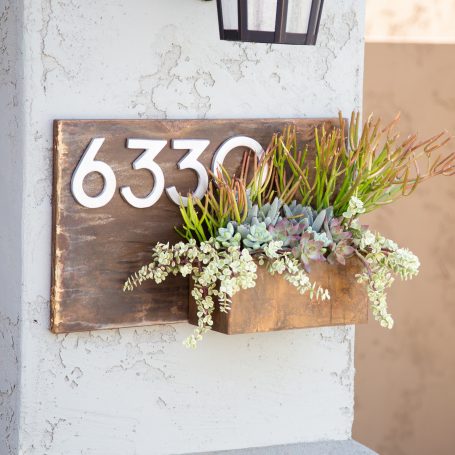
Glass
There's no question that glass is a beautiful material to plant your succulents in. However, glass containers usually lack drainage holes (although the wine bottle planter below has one!).
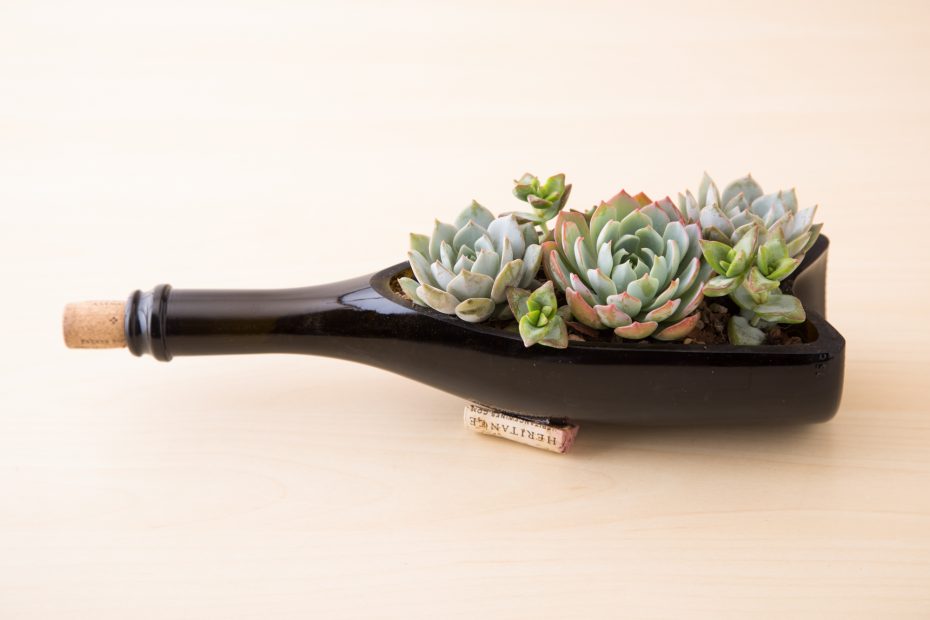
Besides the drainage issue, glass is also not very breathable, which means your soil will have a hard time drying out–unless your container has a wide opening and allows for a lot of airflow.
Glass also gets dirty easily, and has a tendency to collect hard water deposits. And of course, it's also quite breakable, so you have to be careful with where you place your arrangements–especially if, like me, you've got little ones running around your house!
Colors and Textures
Now that you have a good idea of what materials might work best for your succulent planter, the fun really begins! You can take two different approaches to choosing a planter at this point–choose your pot's color and texture based on the succulents you're working with, or pick your succulents based on the pot you want to use.
Cindy Davison of The Succulent Perch is an expert when it comes to pairing pots and succulents. She puts a lot of thought into choosing succulents whose natural colors will mimic or complement the pot she uses.
In this arrangement, for example, she's filled the pot with succulents that are similar in color and shape to the design on the pot. This helps the arrangement look unified and visually appealing.
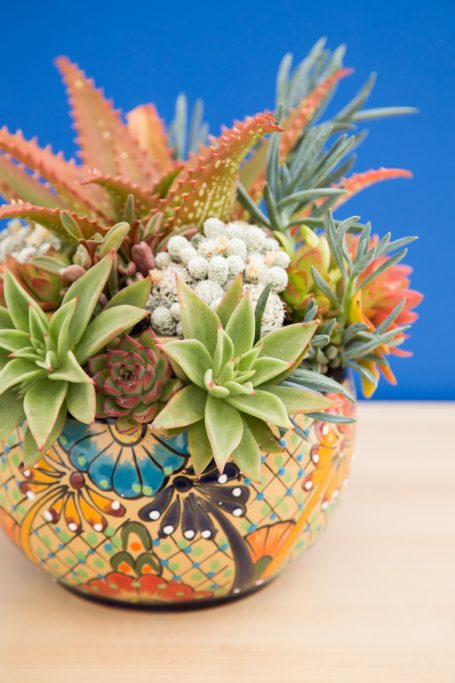
All these choices can get a little overwhelming, I know! If you can't decide what to plant your succulents in, or if you're having a hard time finding just the right pot, a great option is just to fall back on basic terra cotta pots or simple white pottery.
It seems every succulent looks great in one of these and their simplicity helps keep the focus on the succulent.
I've put together a list of some of my favorite pottery on Etsy that works well with succulents. You'll find several from Susan Aach, who is an incredible ceramic artist and always keeps succulents in mind when she creates her unique pieces.
The arrangement below was created by Cindy Davison of The Succulent Perch in a Susan Aach pot.
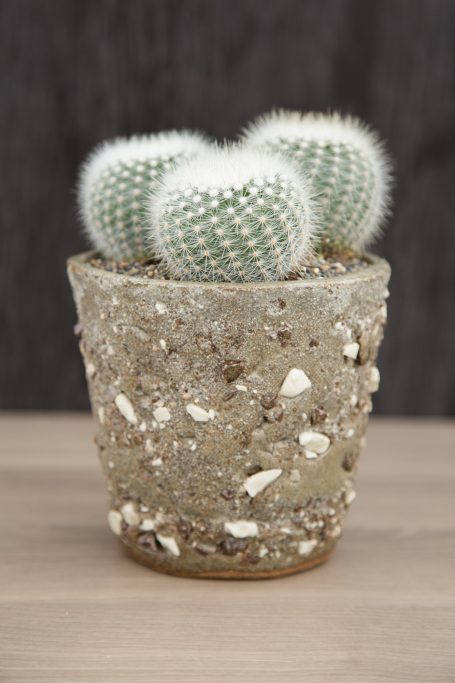
Size considerations
It can often be hard to tell what size of pot you need for your succulents and arrangements. As a general rule, I recommend leaving about a half-inch of space between your succulents and the edge of the pot, so they'll have a little room to spread and grow.
Too much space can actually prevent a succulent from growing much larger, because the roots spread out before the succulent has time to catch up. If you buy a two-inch succulent, a 2.5 inch pot is generally a good choice if you're planting it by itself.
If you're combining a lot of succulents in your arrangement, you'll want to leave a little space around each of them, so they'll have some room to spread out.
A tightly packed arrangement like the one below will look beautiful as soon as it's finished and it generally prevent the succulents from growing as much.
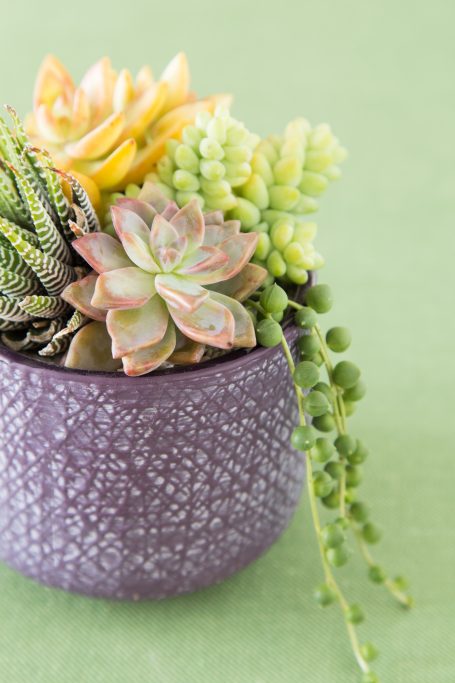
If you want your succulents to get larger and spread, give them a little “breathing room” to allow for new growth. Usually about 1/2″ to 1″ is ideal.
You should now feel more equipped to purchase a new pot for your succulents. While there are a lot of things to consider when choosing a pot, it's still a really fun part of growing succulents.
Once you've selected the right container, it's time to start potting! Check out my post on potting succulents for a step-by-step tutorial.
And don't forget to download my free cheat sheet to see what it looks like when your succulents need more or less water. Click here to grab that, it'll be super helpful.